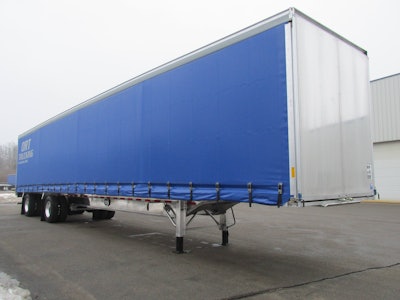
The new trailer order comeback was stopped in its tracks in November, FTR and ACT Research announced Monday.
FTR reports preliminary trailer orders for November at 20,200 units, a 34 percent drop from after the strongest month of the year in October. ACT’s preliminary total was slightly lower at 19,500 net orders.
On a year-over-year comparison, the companies says trailer orders also were down 55 and 56 percent, respectively, from November last year, when limits on OEM capacity resulted in carriers placing huge orders to lock in build slots throughout 2019. FTR states Trailer orders for the last twelve months total 215,000 units.
“Fleets are being more cautious with their truck orders, so it makes sense that trailer orders would follow suit,” says Don Ake, FTR vice president, commercial vehicles. “There is no reason to order in large quantities like last year. The supply of trailers has almost caught up with the demand for trailers, so ordering levels are flattening out and fleets are watching the market closely.
“There is still too much uncertainty regarding the economy, trade, tariffs and politics for companies to have a great deal of confidence right now for 2020.”
“The sequential decline in November broke a four-month streak of monthly gains, [which] ran counter to the industry’s normal order patterns, which point to November typically ranking as the best order month of the year,” adds Frank Maly, director, commercial vehicle transportation analysis and research, ACT Research. “The cautious stance toward 2020 cap-ex spending is evident in both the level and pattern of fleet trailer orders as we approach year-end.”
FTR states OEMs have plenty of capacity to handle a more stable freight and trailer demand environment in 2020, so fleets are placing smaller orders and only ordering a few months out. Production continues to fall moderately on a per-day level, as freight growth has stalled. FTR says there is still a decent demand for dry vans and reefers, but the vocational segments, especially flatbeds, continue to weaken.
Additionally, Maly notes, “One positive take-away from the November stats is a significant easing in cancellations compared to previous months. That’s an indication that, while lower, the commitments on the orderboard appear to be firming as we close the year. Discussions with trailer OEMs also indicate that, although they are encountering pricing pressure, quote activity remains solid, so any change in fleet confidence could quickly result in an order rebound.”
“It is expected that orders will track in this range for a while, as fleets continue to place modest-sized orders for short-term needs. OEM lead times are much shorter than a year ago, so ordering patterns will be much different and more stable than last year’s cycle,” Ake says.











